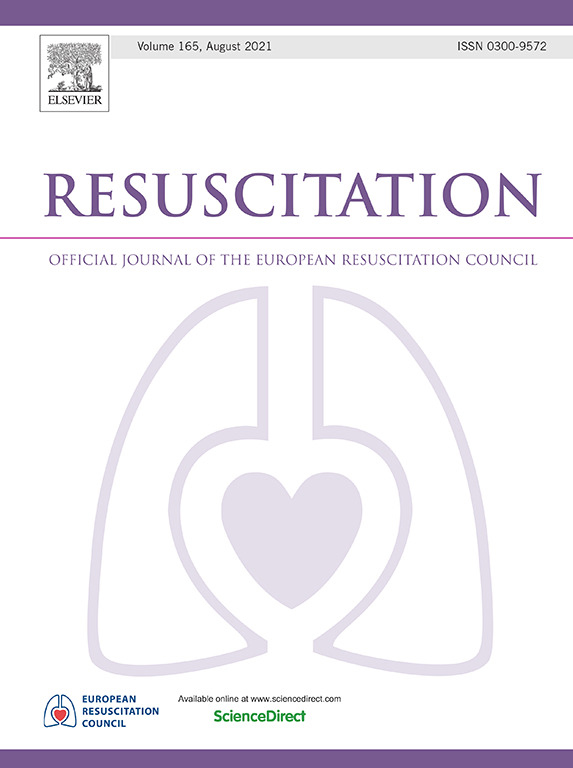婴儿和儿童心脏骤停后血液循环恢复后的血压目标:一项系统综述和荟萃分析。
IF 4.6
1区 医学
Q1 CRITICAL CARE MEDICINE
引用次数: 0
摘要
目的:系统回顾有关婴幼儿院内外心脏骤停后最佳血压指标的文献。方法:我们检索Medline、EMBASE和Cochrane对照试验登记册(CENTRAL),检索截至2025年3月19日的所有年份的随机对照试验和非随机研究。使用Newcastle-Ottawa和GRADE评估偏倚风险和证据确定性。至关重要的预后,从存活到出院,以及有良好神经预后的存活。结果:我们确定了11项观察性研究,包括2855例婴儿和儿童心脏骤停事件。未发现随机临床试验。在血液循环恢复后6小时内,收缩压(SBP)高于5个百分位数的患者与低于5个百分位数的患者相比,在出院时生存风险更高(RR 1.41; 95% CI[1.2至1.6];P=0.01),出院时神经系统预后良好,生存率更高(RR1.25; 95% CI[1.11至1.64];P=0.01)。收缩压大于10个百分位的年龄暴露也与出院时生存率增加和出院时神经预后良好的生存率相关(RR 1.21; 95% CI[1.00至1.33};p10百分位)和舒张压目标(bbb50百分位)也被报道,并与改善的关键结局相关。然而,时间点、血压定义和结果评估的差异限制了汇总分析。偏倚风险低,证据的确定性非常低。结论:心脏骤停后血液循环恢复后早期低血压与婴儿和儿童心脏骤停后较差的预后相关。收缩压或平均动脉血压目标高于年龄的第5和第10百分位的患者,出院时的生存风险和出院时神经系统预后良好的生存风险都有所提高。本文章由计算机程序翻译,如有差异,请以英文原文为准。
Blood pressure targets after return of circulation following cardiac arrest in infants and children: a systematic review and meta-analysis
Aim
To systematically review the literature examining optimal blood pressure targets following in-hospital or out-of-hospital cardiac arrest in infants and children. (PROSPERO ID CRD42023483865).
Methods
We searched Medline, EMBASE, and Cochrane Controlled Register of Trials (CENTRAL) for randomised controlled trials and non-randomised studies for all years up to March 19, 2025. Risk of bias and certainty of evidence was assessed using Newcastle-Ottawa and GRADE. Critically important outcomes survival to hospital discharge and survival with favourable neurological outcome.
Results
We identified 11 observational studies, including 2855 cardiac arrest events in infants and child. No randomised clinical trials were found. Patients exposed to a systolic blood pressure (SBP) greater than 5th percentile for age within six hours of return of circulation, compared to less than 5th percentile had a higher risk of survival to hospital discharge (RR 1.41; 95 % CI [1.2–1.6]; P = 0.01) and better survival with favourable neurological outcome at hospital discharge (RR1.25; 95 % CI [1.11–1.64]; P = 0.01). Exposure to a SBP greater than 10th centile for age was also associated with increased survival at hospital discharge and survival with favourable neurological outcome at hospital discharge (RR 1.21; 95 % CI [1.00–1.33}; P < 0.01 and RR 1.22; 95 % CI [1.10–1.35}; P < 0.01 and RR respectively). Mean Blood Pressure targets (>10th percentile) and diastolic blood pressure targets (>50th percentile) were also reported and associated with improved critical outcomes. However, variation in time points, blood pressure definitions and outcome assessment limited pooled analysis. Risk of bias was low, and the certainty of evidence was very low.
Conclusion
Early hypotension after return of circulation post cardiac arrest is associated with worse outcomes in infants and children after cardiac arrest. Patients exposed to systolic or mean arterial blood pressure targets greater than fifth and tenth percentile for age have improved risk of survival to hospital discharge and survival with favourable neurologic outcomes at hospital discharge.
求助全文
通过发布文献求助,成功后即可免费获取论文全文。
去求助
来源期刊

Resuscitation
医学-急救医学
CiteScore
12.00
自引率
18.50%
发文量
556
审稿时长
21 days
期刊介绍:
Resuscitation is a monthly international and interdisciplinary medical journal. The papers published deal with the aetiology, pathophysiology and prevention of cardiac arrest, resuscitation training, clinical resuscitation, and experimental resuscitation research, although papers relating to animal studies will be published only if they are of exceptional interest and related directly to clinical cardiopulmonary resuscitation. Papers relating to trauma are published occasionally but the majority of these concern traumatic cardiac arrest.
 求助内容:
求助内容: 应助结果提醒方式:
应助结果提醒方式:


